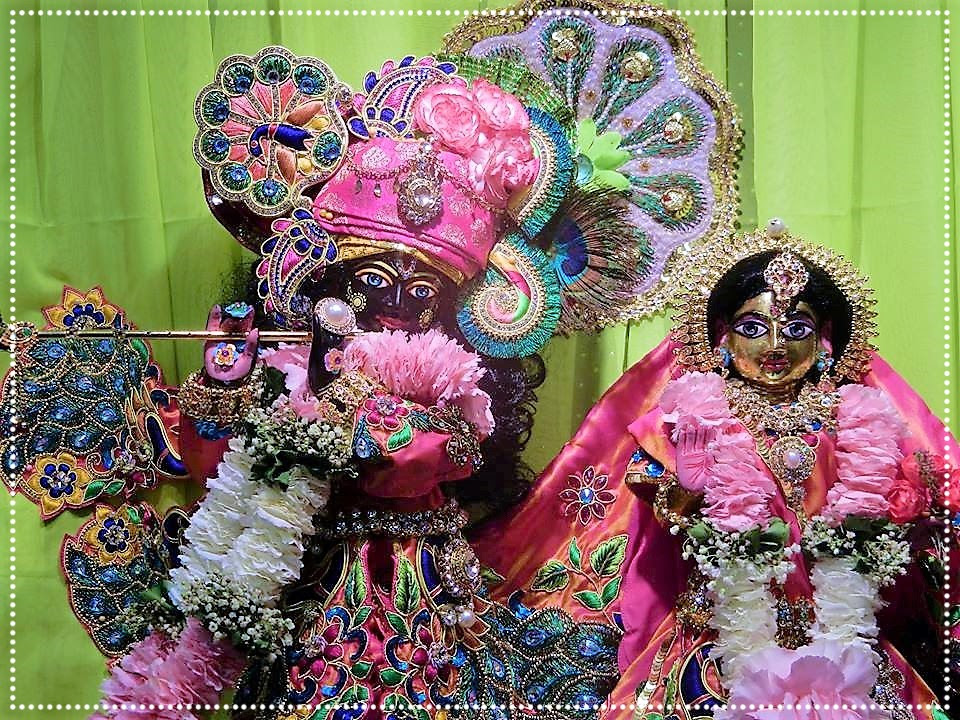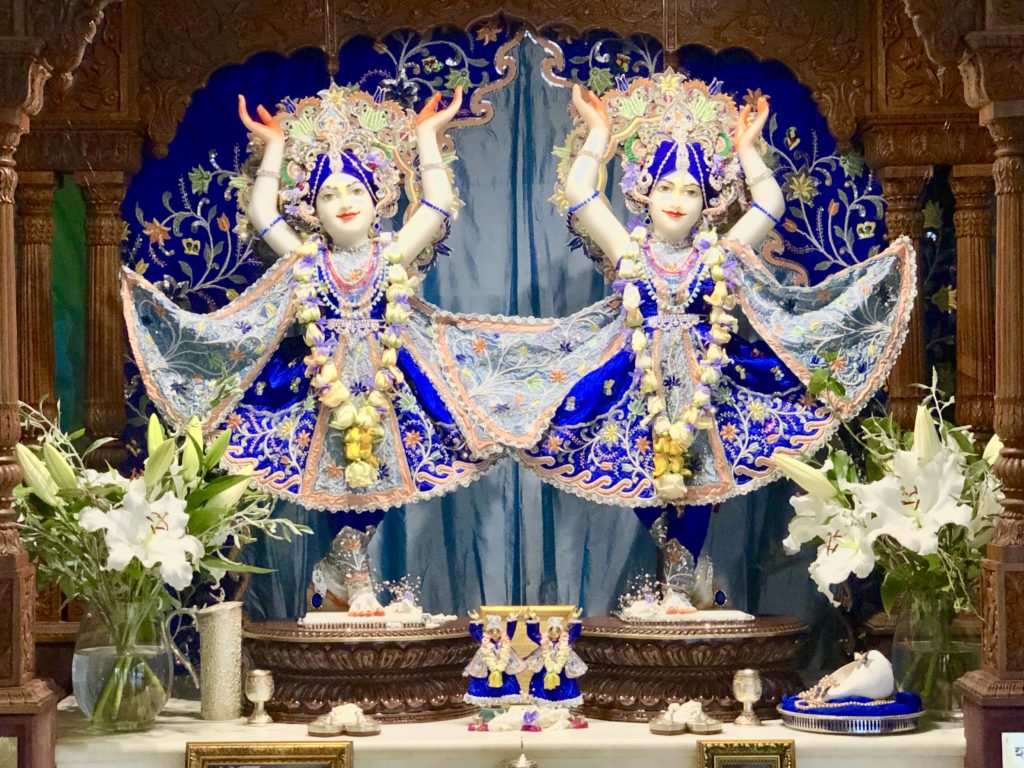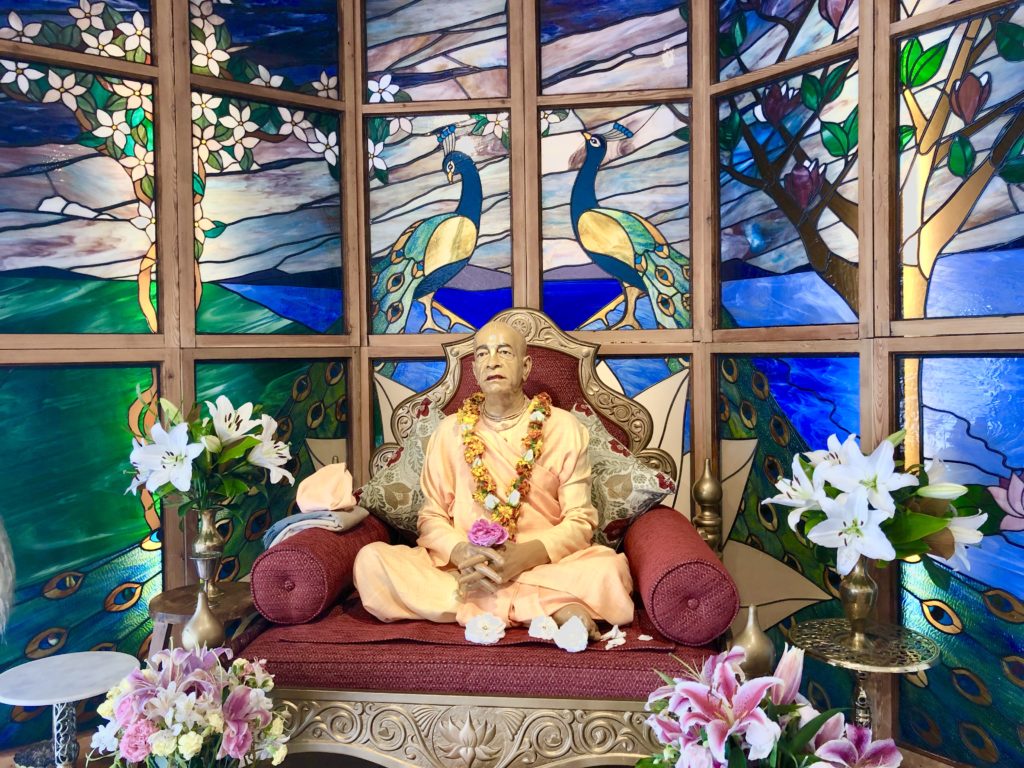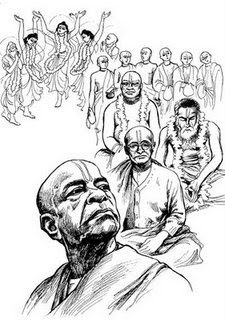Saturday, January 26th, 2019
Friday, January 25, 2019
→ The Walking Monk
Mental Muscle
→ ISKCON News
North American Temple Presidents Prioritize Integrating Next Generation
→ ISKCON News
First Vaishnavi Sanga Retreat Held In Vidarbha
→ Dandavats
 By Jayabhadra devi dasi
By Jayabhadra devi dasi While in Jagannatha and Mayapur yatras in December 2018, I prayed to Lord Jagannatha, “O Lord, I am not doing any service these days. My spiritual master, Lokanath Maharaja, wants me to work hard preaching for the ISKCON Girls’ Forum (IGF), but I am not making much effort. Please guide me O Lord!” Then I thought of arranging a retreat for young women somewhere in the Vidarbha region to share our views and inspire us for the IGF preaching. When I mentioned this to ISKCON Amravati temple president Anantasesa dasa he exclaimed, “So you are organizing Vidarbha Vaishnavi Sanga!’’ That’s how I got the name for the retreat. Continue reading "First Vaishnavi Sanga Retreat Held In Vidarbha
→ Dandavats"
Sun Love Feast – Feb 3rd, 2019 – Vedic discourse by Her Grace Prema Gaurangi Mataji
→ ISKCON Brampton

| |||||
Interview with HH Giriraj Swami by Prasannatma Das, Houston…
→ Dandavats

Interview with HH Giriraj Swami by Prasannatma Das, Houston (video)
Published on Jan 29, 2019
Bhajan by Shivram Das
→ ISKCON News
ISKCON Youth Introduce 300,000 to Maha Mantra at Tampa Pirate Parade
→ ISKCON News
Devotees in the Gasparilla Parade of Pirates, in Tampa, Florida
→ ISKCON News
South Africa, September 2018 – Audio Recordings
→ KKSBlog

It is catch-up time! Here is the first part of many audio recordings of Kadamba Kanana Swami captured during 2018.
CAPE TOWN
KKS_SA_CPT_18Sept2018_Lecture_BG_10.10
KKS_SA_CPT_19Sept2018_Lecture_SB_1.18.38
KKS_SA_CPT_19Sept2018_Evening_Kirtan
KKS_SA_CPT_19Sept2018_Evening_Lecture
KKS_SA_CPT_20Sept2018_HomeProgram_Kirtan
KKS_SA_CPT_20Sept2018_HomeProgram_Lecture
KKS_SA_CPT_20Sept2018_UniversityProgram_Lecture
KKS_SA_CPT_22Sept2018_Jaiva-dharma-katha
DURBAN
KKS_SA_DBN_13Sept2018_Lecture_SB_3.8.22
KKS_SA_DBN_13Sept2018_Northdene_Kirtan
KKS_SA_DBN_13Sept2018_Northdene_Lecture
KKS_SA_DBN_14Sept2018_Kendra_Namahatta_Kirtan
KKS_SA_DBN_14Sept2018_Kendra_Namahatta_Lecture
KKS_SA_DBN_15Sept2018_Kirtan_before_lecture
KKS_SA_DBN_15Sept2018_Pre-Radhastami_Katha
KKS_SA_NJP_16Sept2018_New-Jagannath-Puri-Temple_Kirtan1
KKS_SA_NJP_16Sept2018_New-Jagannath-Puri-Temple_Kirtan2
KKS_SA_NJP_16Sept2018_New-Jagannath-Puri-Temple_Lecture
KKS_SA_DBN_17Sept2018_Radhastami_Morning_Lecture
KKS_SA_DBN_17Sept2018_Radhastami_Kirtan_Abhisek
KKS_SA_DBN_17Sept2018_Radhastami_Evening_Lecture
KKS_SA_JHB_08Sept2018_Initiation_Ceremony_Lenasia
The article " South Africa, September 2018 – Audio Recordings " was published on KKSBlog.
World Sankirtan Newsletter 2018 – highest scores in the last 20 years!
→ Dandavats
 By Vijaya das
By Vijaya das Amazing things happened in 2018, starting with the New Delhi devotees, who never cease to amaze us. They had their biggest year ever and the biggest year in ISKCON's history, with 1,850,250 book points. What can we say about that, but JAYA! and JAYA! again.
The Nairobi temple in Kenya, Africa, which did 6,115 book points in 2017, did 57,932 book points last year. I don't know what inspired the huge increase, but something auspicious happened to the devotees' consciousness. I've distributed there before, and believe me it's not easy.
In Europe, London took the lead with 69,872 book points, just barely exceeding the score of Bhaktivedanta Manor. There is a close competition between the two temples, which are also geographically close, only about twenty kilometers apart. In 2017, the Manor ended up ahead of London by just 185 book points. So apparently London decided to not have any more of that and took a narrow lead in 2018. The Manor did 66,469 points for second place. Srila Prabhupada liked transcendental competitions. Continue reading "World Sankirtan Newsletter 2018 – highest scores in the last 20 years!
→ Dandavats"
ISKCON AHMEDABAD HOLDS 2019’S FIRST ONE-DAY WALK
→ Dandavats

ISKCON AHMEDABAD HOLDS 2019’S FIRST ONE-DAY WALK
Muralimohan dasa: Continuing the successful model of doing a one-day padayatra every month, the ISKCON Ahmedabad devotees celebrated this year’s first padayatra on January 13. Padayatra began at 8am at the Boot-Bhavani temple with forty-five devotees, Srila Prabhupada, and the beautifully dressed Sri Sri Nimai-Nitai and headed for upmarket Bakeri City in Vejalpur, where the devotees performed sankirtan and distributed Bhagavad-gitas to the neighbourhood’s well-informed residents. Magnetized by the mercy of the Lord, one family expressed their desire to attend Bhagavad-gita classes at the ISKCON temple regularly. The devotees did kirtan at Shishir prabhu’s house at Bakeri City after he had performed arati to Nimai-Nitai and Srila Prabhupada, and everyone then honoured the breakfast prasadam that Shishir had sponsored.
Kirtan continued throughout the walk, the exciting spectacle compelling the public at every square to chant the Hare Krishna maha-mantra loudly and raise their hands. From Bakeri City padayatra made its way past the R. R. Trivedi School, the Krsna-nagar society, the Chandrashekar society, the Hotel Cambay, Jivraj Square and Vejalpur Lane and ended at Srinanda-nagar in Vejalpur at 12pm, the party now 150 strong. The residential devotees welcomed padayatra’s sankirtan and garlanded Gaura-Nitai, Srila Prabhupada and a few devotees. Sanjay Krishna dasa, a disciple of Kavichandra Swami Maharaja, and Sahishnu Krishna dasa, a disciple of Jayapataka Swami Maharaja, then addressed the devotees for twenty minutes each on the importance of padayatra and chanting the holy names on the streets.
Ashok Wala prabhu, from the family of Jagatjanani devi dasi, sponsored the prasadam feast to conclude our one-day padayatra. We honoured the family by garland and everyone calling out the Hare Krishna maha-mantra. Such fruitful events invigorate us to continue organizing padayatras, thus fulfilling the mission of Caitanya Mahaprabhu.
Book Distribution: Eleven devotees distributed Srila Prabhupada’s books on the padayatra and the final book score was eighty big books, three maha-big books and twenty-two small books, along with some donations. All glories to the book distributors. We also announced a surprise gift for the distributor with the highest score, Padmaradha devi dasi.
More photos: https://goo.gl/CtK7gp
Networking At Kumbha Mela (Album of photos)
Indradyumna Swami:…
→ Dandavats

Networking At Kumbha Mela (Album of photos)
Indradyumna Swami: Upon arriving at the Kumbha Mela in Prayag Raj I was invited to stay in the area where most of the prominent sadhus are staying. I took it as an opportunity to network and share the mission of Srila Prabhupada with many of the recognized spiritual leaders of India. Indeed within minutes, I was on stage sitting next to the Deputy Chief Minister of Uttar Pradesh. After exchanging pleasant words I shared with him some of the glories of Srila Prabhupada. As the evening wore on I was able to do the same with a number of the sadhus on stage. May Srila Prabhupada’s glories be spread throughout the 14 worlds!
Find them here: https://goo.gl/rx6Mfp
The 2019 North American Temple President’s Meeting was a grand success!
→ Dandavats
 By Mukhya devi dasi
By Mukhya devi dasi Thirty-nine Temple presidents including 4 GBCs and Support Office leaders met in a perfect facility just down the road from the Potomac Temple. We concentrated on how we wanted to work together, what resources we needed to better serve our temples and where to find them, and how we wanted the relationship between TPs and GBCs to look and feel. This took one of our days where each TP spoke to what was working, what they needed and how all of our own responsibilities and habits play into the relationship. Continue reading "The 2019 North American Temple President’s Meeting was a grand success!
→ Dandavats"
Krishna assumes a childlike form – does this mean he has some other original form?
→ The Spiritual Scientist
Answer Podcast
The post Krishna assumes a childlike form – does this mean he has some other original form? appeared first on The Spiritual Scientist.
Interview with Giriraj Swami by Prasannatma Das, Houston
Giriraj Swami
Sri Nitai Gauracanda Temple
→ Ramai Swami


I always enjoy visiting Sri Nitai Gauracanda temple in Christchurch. The dieties are beautiful in Their dancing pose and the devotees so welcoming when visitors come.
The temple here had to be rebuilt after the big earthquake in 2011 and it opened just a few years ago. Now Their Lordships have a brand new facility, with bigger temple room and kitchen that serves the growing community.


Celebrating Our Volunteers!
→ Dandavats

Celebrating Our Volunteers!
Aindavi Devi Dasi: Most visitors to New Govardhana remark what a vibrant and beautiful place it is. They are impressed with the many happy, engaged visitors from Krishna Village dotted all over the farm. Well, quite frankly, so are we!
The New Govardhana goshalla team is expanding!
→ Dandavats

The New Govardhana goshalla team is expanding!
Karunamayi dasi: Over recent years the team has been stretching itself, but with new enthusiastic devotees gaining interest and taking on different services within the program, it is certainly an exciting time for cow seva.
Mukunda Goswami at Gurukula’s End Of The Year Ceremony
→ Dandavats

Mukunda Goswami at Gurukula’s End Of The Year Ceremony (5 min.video)
End of the Year Gurukula Assembly New Govardhana (Australia) 18 Dec 2018.
Interview with Mandali-Kishori Devi Dasi
→ Dandavats

Interview with Mandali-Kishori Devi Dasi.
Q: How did you first come into contact with ISKCON?
MK: I met a book distributer three years ago in Cape Town while on a family holiday. When I returned to New Zealand, I started university in Wellington where I began visiting Bhakti Lounge, ISKCON’s outreach center there.
Krishna’s Fascination
→ Dandavats

Krishna’s Fascination.
By Sacinandana Swami: Krishna is fascinated with the land and people of Vrindavan.
The Bhagavatam says (10.1.28): “The city and district of Mathura,” Vrindavan is part of that, “are very intimately connected with Krishna, for Lord Krishna lives there eternally.”Nityam sannihito harihi – He is there eternally.
Read More...
New Donor Annual Receipts Function on TOVP Website
- TOVP.org
As a service to TOVP donors, the TOVP website DONOR ACCOUNT tab now has a new feature to facilitate annual accounting; Annual Receipts.
At the top right hand corner of every Page on the TOVP website there is a tab named, DONOR ACCOUNT. From this link donors can access all their donation history details, print receipts, etc., after entering their proper ID (email address). The newest feature to this service allows donors to locate their total annual donations and download/print a PDF for tax and accounting purposes. Here are the highlights of this function:
With the Annual Receipts:
- Donors can download a record of all donations within a given year for their records and tax purposes.
- Accountants can use the record of their client’s donations to accurately file their charitable contribution deductions using the contact info and donation totals within the annual receipt.
- Charities and Site Admins can use this convenient method of delivering annual receipts to donors to fulfill their obligations regarding charitable receipts.
Please Note: This new feature is only retroactive to 2018.
The Annual Receipts provides our website the tools our donors need for year-end tax purposes. This enables them to provide their accountants with the necessary information to report on their annual charitable giving for tax purposes. Providing this convenience to our donors encourages their trust in our organization so that they might be more inclined to continue supporting our organization financially.
The post New Donor Annual Receipts Function on TOVP Website appeared first on Temple of the Vedic Planetarium.
Service to the devotees
→ KKSBlog

(Kadamba Kanana Swami, 01 December 2014, Mayapur, India, Srimad Bhagavatam 6.1.50)
Question: To a certain degree, we may want to become pure devotees, but how can we make this desire more solid?
Srila Prabhupada explains that everything moves by taste, because if there is no taste, then it is very difficult to do anything. Srimad Bhagavatam 1.2.16 says: śuśrūṣoḥ śraddadhānasya, vāsudeva-kathā-ruciḥ, syān mahat-sevayā viprāḥ, puṇya-tīrtha-niṣevaṇāt.
We should serve the vaisnavas and in that way, we will get the taste to hear about Krsna. Once we have taste to hear about Krsna, then that desire will come. Because by hearing about Krsna, the desire to become a pure devotee will become stronger. So, it all begins with serving the vaisnavas.
Question: What does it take to be a pure devotee?
First thing is to serve a pure devotee but not just to serve a pure devotee a little bit. No! It means to give one’s life to a pure devotee, to understand, ‘I am the property of that pure devotee!’ In that way, one can become a pure devotee. That is the first thing. Ado guru-padasraya (Caitanya Caritamrta Madhya 22.115) – first we should become a property of a pure devotee.
The article " Service to the devotees " was published on KKSBlog.
Kirtan standards in Iskcon (video)
→ Dandavats

Kirtan standards in Iskcon (video)
A Vaishnava Sanga festival in ISKCON Ottawa. Seminar by Bhaktimarga Swami.
Cooking with Dasa Goswami (8 min.video)
→ Dandavats

Cooking with Dasa Goswami (8 min.video)
The first video of series “Cooking with Dasa Goswami” is here! Please see it together with the comments of Maharaj below.
Dhirasanta Dasa Goswami: There is an endless number of Vedic recipes which are available to satisfy the taste buds. These are dishes made from a variety of vegetables, fruits nuts, grains, milk products, and spices. These recipes date back 5000 years ago when Lord Krishna would daily feast along with his friends in Vrindavan to their full satisfaction.
Won’t saying that God is not the sole controller imply that he is helpless in certain situations?
→ The Spiritual Scientist
Answer Podcast
The post Won’t saying that God is not the sole controller imply that he is helpless in certain situations? appeared first on The Spiritual Scientist.
Resist the mind just as Sita resisted Ravana – Hindi
→ The Spiritual Scientist
[Sunday feast class at ISKCON, Belgaum, india]
Podcast
Podcast Summary
Video:
The post Resist the mind just as Sita resisted Ravana – Hindi appeared first on The Spiritual Scientist.
Mohini Murti pastime analysis – Hindi (3)
→ The Spiritual Scientist
The post Mohini Murti pastime analysis – Hindi (3) appeared first on The Spiritual Scientist.
Mohini Murti pastime analysis 3 – When shame helps devotion and when it hurts devotion – Hindi
→ The Spiritual Scientist
[Class at ISKCON, Belgaum, India]
Podcast
Podcast Summary
Video:
The post Mohini Murti pastime analysis 3 – When shame helps devotion and when it hurts devotion – Hindi appeared first on The Spiritual Scientist.
Mohini Murti pastime analysis 2 – Even sensual failure can be a spiritual success – Hindi
→ The Spiritual Scientist
[Class at ISKCON, Belgaum, India]
Podcast
Podcast Summary
Video:
The post Mohini Murti pastime analysis 2 – Even sensual failure can be a spiritual success – Hindi appeared first on The Spiritual Scientist.
Mohini Murti pastime analysis 1 – Even the Lord’s cheating is all-good – Hindi
→ The Spiritual Scientist
[Class at ISKCON, Belgaum, India]
Podcast
Podcast Summary
Video:
The post Mohini Murti pastime analysis 1 – Even the Lord’s cheating is all-good – Hindi appeared first on The Spiritual Scientist.
Vaishnava Seva pleases guru.
This story from the life of Srila…
→ Dandavats

Vaishnava Seva pleases guru.
This story from the life of Srila Ramanujacharya illustrates the importance of serving the devotees.
* UNCONVENTIONAL GUIDANCE – Srila Bhaktisiddhanta Saraswati Thakur offers some startling comments regarding the above story of Ramanuja.
To read the complete article please click here: https://archive.org/details/bindu442
The Original Personality of Godhead (video)
→ Dandavats

The Original Personality of Godhead (video)
ISKCON SanDiego: Srimad Bhagavatam Class by HH Badrinarayan Swami.
Temple New Purushottama kshetra ISKCON Dnipro Ukraine
→ Dandavats

Temple New Purushottama kshetra ISKCON Dnipro Ukraine (12 min.video)
Srila Prabhupada: These are the symptoms of one who chant...
“Don’t take me to the hospital”
→ Dandavats

“Don’t take me to the hospital”
Srila Prabhupada did not like to be experimented on by drug giving doctors and in one story it was Gargamuni and Brahmananda that he got to take him out of the hospital, prematurely, in the eyes of the doctors.
Read More...
Travel Adventures of a Krishna Monk.
Diary of a Traveling…
→ Dandavats

Travel Adventures of a Krishna Monk.
Diary of a Traveling Sadhaka, Vol. 15, No. 1
By Krishna-kripa das.
Rama Raya P...
TOVP: Pillar Work Progress
The Temple of the Vedic Planetarium…
→ Dandavats

TOVP: Pillar Work Progress
The Temple of the Vedic Planetarium has 108 pillars within it, appropriately named the Pillars of D...
The Cows of Iskcon Mayapur! (15 min.video)
→ Dandavats

The Cows of Iskcon Mayapur! (15 min.video)
“namo brahmanya-devaya go-brahmana-hitaya ca…
His first business is to give all comfort to the cows and the brahmanas. In fact, comfort for the brahmanas is secondary, and comfort for the cows is His first concern.”
- Srimad Bhagavatam 10.8.16, purport
With the desire to spread the glories of mother cow and bring awareness of the care offered by Iskcon Mayapur Goshala, the communication department put together a video which we would like to share with you all.
This video will take you through many aspects undertaken for caring of the cows in Iskcon Mayapur Goshala.








 Adult Education At The Temple
Adult Education At The Temple






